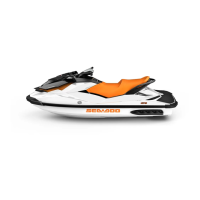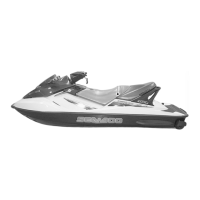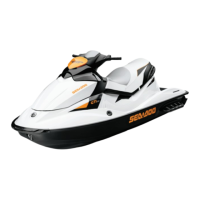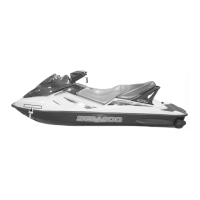OPERATING INSTRUCTIONS
If the throttle lever is still pulled in
when releasing the iBR lever, the wa-
tercraft will accelerate forward after a
short delay. Acceleration will be pro-
portional to the throttle lever position.
WARNING
If forward acceleration is not de-
siredwhenthebrakeleverisre-
leased, release the throttle lever.
When at speed and the brake is first
applied, a plume of water will shoot up
in the air behind the watercraft which
may cause the operator of a following
watercraft to momentarily loose sight
of your PWC.
WARNING
– It is important to inform the
operator of a watercraft who
intends to follow in a convoy
formation, of the braking and
maneuvering capability of your
PWC, what the plume of water
indicates, and that a greater dis-
tance must be maintained be-
tween watercraft.
– Be aware that other boats fol-
lowing or operating in close
proximity may not be able to
stop as quickly.
Braking in a Turn
iBR Equipped Models Only
Throttle must be applied for turnin
gto
ensure directional control. However
braking can be initiated during a turn
using the iBR lever as previously
de-
scribed. Get ready to maintain your
balance while the wake is crossing
your PWC.
CAUTION As the watercraft
slows to a stop while braking in a
turn, the wake created by the water-
craftwillcatchupandtendtopush
the watercraft sideways. Be pre-
pared to maintain balance as the
wake crossed the watercraft.
How to Use the Variable
Trim System (VTS)
The variable trim system (VTS)
changes the vertical position of the jet
pumpnozzletoprovidetheoperator
with a fast, effective system to com-
pensate for load, thrust, riding position
and water conditions. Correctly ad-
justed, it can improve handling, reduce
porpoising, and position the watercraft
at its best riding attitude to attain maxi-
mum performance.
When first using the watercraft, the
operator should become familiar with
the use of the variable trim system
(VTS) at varying speeds and water con-
ditions. A mid-range trim is generally
used when cruising. Experience alone
will dictate the best trim for the condi-
tions. During the watercraft break-in
period, when lower speeds are recom-
mended, it is an excellent opportunity
to become familiar with trim adjust-
ment and its effects.
When the nozzle is positioned in an
upward angle, the water jet directs the
bow of thewatercraft upward. This po-
sition is used to optimize high speed.
When the nozzle is directed down-
ward, the bow is forced downward
and increases the watercraft turning
capabilities. As with any watercraft,
speed and operator body position
and
movement (body English), will deter-
mine the degree and sharpness of the
watercraft turn. Porpoisin
gcanbere-
duced or eliminated if the nozzle is
downward and speed is adjusted pro-
portionately.
NOTE: VTS position is indicated on a
bar gauge in the informati
on center.
_______________
81
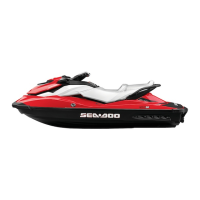
